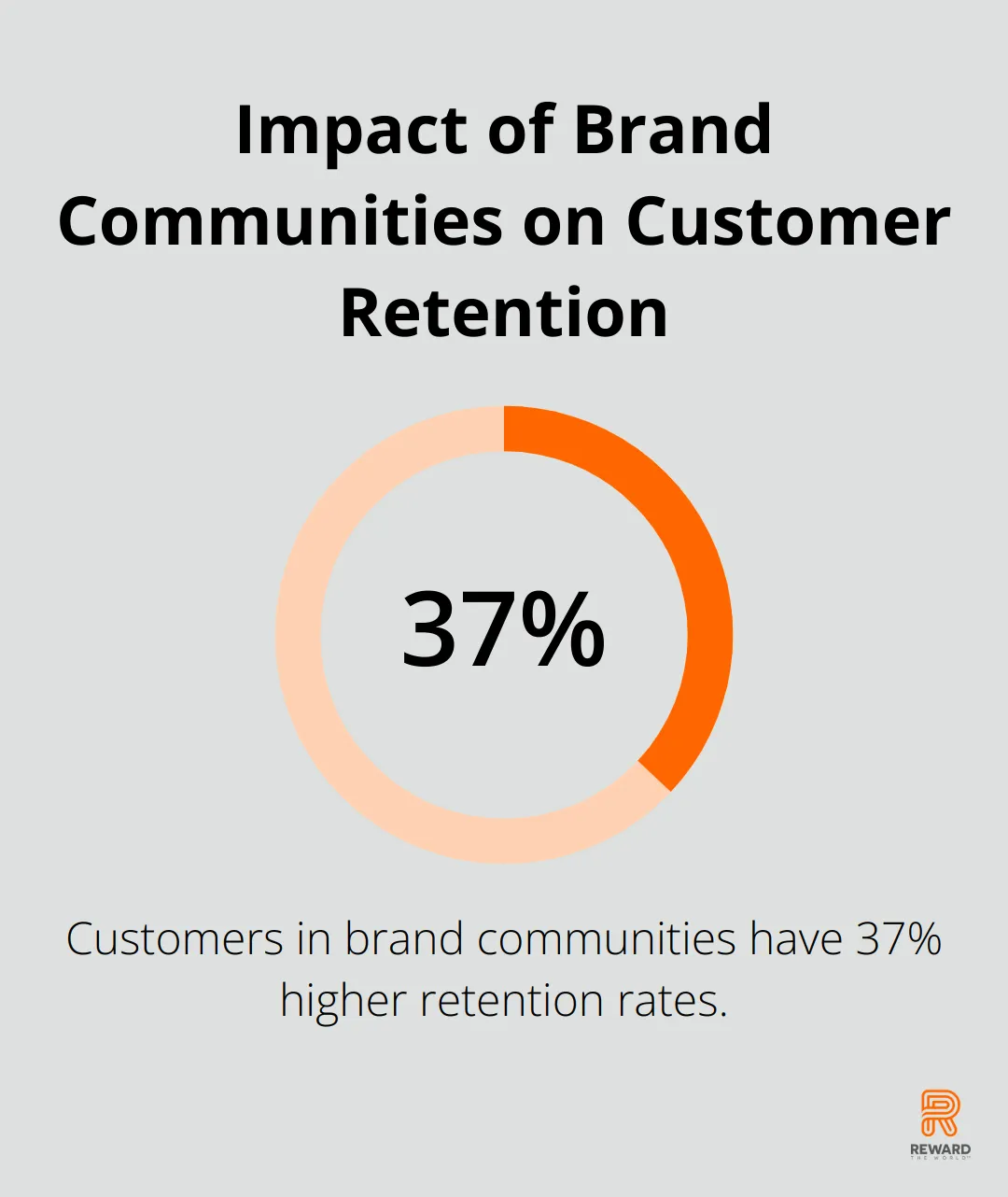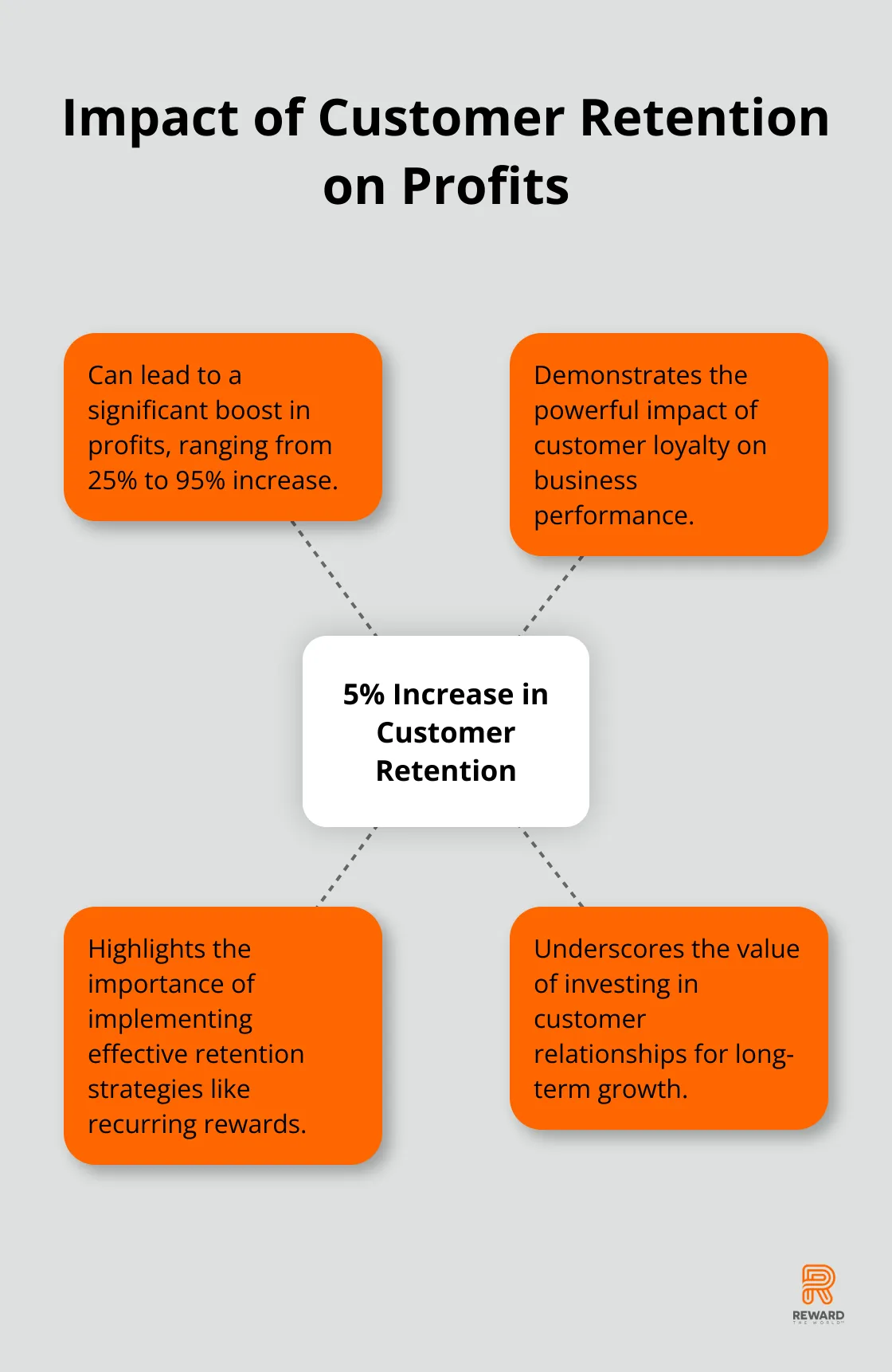
At Reward the World, we’ve seen firsthand how recurring rewards can transform customer loyalty.
Subscription loyalty programs are revolutionizing the way businesses retain customers. These programs tap into powerful psychological principles, creating a cycle of engagement that keeps customers coming back.
In this post, we’ll explore why recurring rewards are so effective and how you can implement them to boost your retention rates.
Why Do Recurring Rewards Work So Well?
Recurring rewards are a powerful tool for customer retention. Their effectiveness lies in the way they tap into fundamental aspects of human psychology. These rewards create a cycle of engagement that keeps customers coming back time and time again.
The Power of Positive Reinforcement
Positive reinforcement drives the success of recurring rewards. When customers receive regular benefits for their loyalty, it strengthens their positive association with a brand. Research from the Community Business Network shows that customers participating in brand communities demonstrate 37% higher retention rates compared to those who don’t.

Habit Formation Through Consistency
Consistency plays a vital role in building habits. Businesses can create a pattern of behavior that becomes ingrained in their customers’ routines by offering rewards at regular intervals. Emerging evidence on health-related habit formation indicates that while habits can start forming within about two months, the time required varies.
Anticipation as a Motivator
The anticipation of future rewards can be just as powerful as the rewards themselves. A neuroimaging study published in the Journal of Neuroscience revealed that the brain’s reward centers activate not just when receiving a reward, but also when anticipating one. This explains why customers often increase their engagement as they approach their next reward milestone.
Implementing Effective Recurring Rewards
To harness these psychological principles effectively, businesses should consider implementing a tiered reward system. This approach involves starting with small, frequent rewards to build habits, and gradually increasing the value of rewards over time. It keeps customers engaged in the short term while also giving them something to strive for in the long run.
The key to a successful recurring reward program is to strike a balance between predictability and excitement. While customers should be able to rely on regular rewards, occasional surprises can reignite interest and prevent the program from becoming stale.
The Role of Technology in Recurring Rewards
Modern technology (such as AI and machine learning) plays a crucial role in optimizing recurring reward programs. These tools allow businesses to analyze customer behavior, predict preferences, and personalize rewards accordingly. This level of customization enhances the effectiveness of recurring rewards, making them more appealing to individual customers.
As we move forward, let’s explore how businesses can implement effective recurring reward programs that not only retain customers but turn them into enthusiastic brand advocates.
How to Implement Effective Recurring Reward Programs
Optimizing Reward Frequency
The success of a recurring rewards program hinges on finding the right frequency for rewards. Too many rewards can diminish their value, while too few might cause customers to lose interest. A study in the Journal of Marketing Research revealed that customers who received bi-weekly rewards showed a 17% increase in engagement compared to those with monthly rewards.

We recommend a bi-weekly reward schedule as a starting point. This approach provides regular touchpoints without overwhelming customers or straining resources. However, it’s essential to monitor customer feedback and engagement metrics to fine-tune this frequency over time.
Balancing Predictability and Surprise
While consistency forms the backbone of a successful rewards program, introducing an element of surprise can reignite customer interest. A Harvard Business Review study found that immediate rewards increased customer spending by up to 30% compared to delayed rewards of higher value.
Try to implement a “surprise and delight” strategy alongside your regular rewards. You could offer double points on random days or send out surprise gift cards to top customers. These unexpected bonuses (which we call “micro-moments of joy”) keep customers excited about your program without disrupting the predictable core rewards.
Personalizing Rewards for Maximum Impact
Personalization has evolved from a luxury to a necessity in today’s market. New research from Epsilon uncovers how consumers feel about personalization in marketing and advertising. This underscores the importance of tailoring rewards to individual preferences.
Use your customer data to offer rewards that align with individual tastes. For a customer who frequently purchases electronics, tech-related rewards might be most appealing. Fashion enthusiasts might appreciate exclusive discounts from clothing brand partners.
Leveraging Technology for Seamless Implementation
Modern technology plays a pivotal role in optimizing recurring reward programs. Artificial Intelligence (AI) and machine learning tools allow businesses to analyze customer behavior, predict preferences, and personalize rewards accordingly. This level of customization enhances the effectiveness of recurring rewards, making them more appealing to individual customers.
A robust rewards platform capable of handling complex personalization and delivery schedules is essential for implementing these strategies effectively. While several options exist in the market, Reward the World’s platform excels in seamlessly integrating these features, ensuring a smooth experience for both businesses and customers.
As we move forward, let’s explore how to measure the impact of these recurring reward programs on customer retention and overall business performance.
How to Measure the Impact of Recurring Rewards
Measuring the impact of recurring rewards is essential for optimizing your customer retention strategy. We’ll explore key metrics and analysis techniques to help you assess the success of your recurring rewards program.
Key Retention Metrics
Customer retention rate serves as the primary metric for any loyalty program. Calculate this by dividing the number of customers at the end of a period by the number at the start (excluding new customers acquired during that time). A 5% increase in customer retention can lead to a 25-95% increase in profits.

The Net Promoter Score (NPS) measures customer loyalty and likelihood to recommend your brand. Companies in the top NPS quartile achieve on average 25% higher revenue growth.
Engagement metrics also play a vital role. Track how often customers interact with your program, redeem rewards, or make purchases.
Understanding Customer Lifetime Value
Customer Lifetime Value (CLV) indicates your recurring rewards program’s success. It represents the total revenue you can expect from a customer throughout their relationship with your brand.
A simple formula for measuring customer lifetime value is: Customer revenue per year * Duration of the relationship.
Comparing Recurring and One-Time Rewards
When comparing recurring and one-time reward programs, examine both short-term and long-term metrics. One-time rewards might show a spike in short-term engagement, while recurring rewards often lead to sustained loyalty.
This highlights the importance of tailoring your recurring rewards to individual preferences. Use data analytics to segment your customers and offer rewards that resonate with each group. For instance, a tech-savvy millennial might prefer digital rewards, while a baby boomer might value traditional gift cards more.
Monitoring Brand Advocacy
The goal extends beyond customer retention; it’s about creating brand advocates. Monitor social media mentions, referrals, and user-generated content as indicators of how well your recurring rewards program turns customers into ambassadors for your brand.
Focus on these key metrics and continuously refine your approach based on data-driven insights to maximize the impact of your recurring rewards program and drive long-term customer loyalty.
Final Thoughts
Recurring rewards transform customer retention strategies. These programs create a powerful engagement cycle through positive reinforcement, habit formation, and anticipation. Subscription loyalty programs increase customer lifetime value, boost retention rates, and strengthen emotional connections between customers and brands.
Effective recurring reward programs balance predictability with surprise. Regular rewards build habits, while unexpected bonuses maintain excitement. Personalization enhances impact, and technology enables sophisticated analysis of customer behavior. Continuous measurement of key metrics allows businesses to optimize their programs for maximum effectiveness.
The future of customer retention lies in subscription loyalty programs that offer consistent value. We at Reward the World provide a comprehensive solution for recurring rewards that combines cutting-edge technology with diverse reward options. Our platform helps businesses harness the power of recurring rewards to build lasting customer relationships and drive growth.
